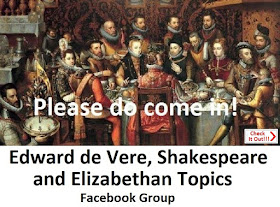 |
| It's that time again! It's Tudor Trivia Tuesday! |
1) In some places, in Tudor England, gooseherders herded
geese much like sheepherders sheep. “…[it
is] strange to me to see or heare of geese to be led to the field like sheepe:
yet so it is: their gooseheard carieth a rattle of paper or parchment with him,
when he goeth about in the morning to gather his goslings togither, the noife
whereof commeth no fooner to their eares, than they fall to gagling, and hasten
to go with him.” [Harrison]
2) During the marriage of Queen Mary and King Phillip, Spanish
coins were allowed to be minted at The Tower Mint.
3) Queen Elizabeth I called back sir Edward Carne, resident from
the English government at the court of Rome, on February 1, 1558, leaving the
post vacant. The Pope ordered the
ambassador to remain in order to save him from persecution upon his
return. Carne died within the year.
4) The Shakespeare scholar Charles Knight was of the opinion
that the Bard must have based the pageant in Love’s Labour's Lost, Act
V, Sc 2., upon “'The Nine Worthies' a pageant peculiar to [the English town of]
Chester”.
5) Malt for brewing was a lucrative sideline for some
English Tudor farmers. In Harrison’s Description
of England we learn: “The best malt is tried by the hardnesse & colour,
for if it looke fresh with a yellow hew, & thereto will write like a peece
of chalke, after you have bitten a kirnell in sunder in the midest, then you
may assure your selfe that it is [properly] dried downe.”
6) Henry Manchyn recorded in his diary, under September 3,
1562, the arrival in London of the 12 year old Earl of Oxford, Edward de
Vere. “The iij day of September cam
rydyng owt of Essex from the funeral of the [Earl] of Oxford [his] father the
yonge [Earl] of Oxford, with vij-s[c]ore horse all in blake throughe London and
Chepe and Ludgatt, and so to Tempulle [Bar], and so to [blank], be[tween] v and
vi of the cloke at after-[noon].” The
young Earl had arrived to be taken in as ward of the Queen.
7) Hypocras was considered more a medicine than a spiced
wine for general drinking for centuries after its creation. This was still the case as late as August of
1575 when the Corporation of Worcester (which town the Court was visiting)
arrived at the door of the chambers of the Earl of Sussex, Lord Chamberlain with
a present of two gallons of hypocras.
The Chamberlain had been unable to attend most of the festivities as he
was ill. ‘[B]eing in his bede and some what
diseased, [he] sent them very hartie thanks by his Secretary; but they spake
not with hym.’
8) In a letter of the 17th of June, 1580, “Sir Nicholas Woodrofe,
Lord Mayor, to Lord Burghley, Lord High Treasurer,” the mayor includes a list of complaints he
hopes Burghley will bring to the attention of the Queen. Among them he asks that “killing of Cattell
within or nere the Cittie, be restrained and that the same be done in places to
be prouided a myle or twoo distant from London, and so the vitall to be brought
by cart or boat, for not onely the bludd and entrailes are noisome [smelly] but
also by occasion thereof they kepe swine that sture vp the same and increase
the annoyance”.
9) In Twelfth
Night, Sir Toby says regarding Malvolio, Steward to Olivia,
Toby. Wouldst thou not be glad
to have the niggardly
Rascally sheepe-biter, come by some
notable shame?
The epithet “sheep-biter” was very common in the 16th
century and was implied to mean many things.
Its original meaning, however, was “mutton-eater”. The many negative implications it was given
come from the belief that eaters of mutton were effete and/or lacking in
physical and subsequently moral vigor.
10) The stomacher was common to both sexes, in Tudor times,
but it was generally called the placard when it belonged to the men. [Strutt]
Also at Virtual Grub Street:
- The Secret Correspondence of Robert Cecil and James I. August 25, 2019. “As he was planning an armed attempt to “secure the person of the Queen,” after having returned from the country, in disgrace, and to force her to dismiss ministers who did not satisfy him, he was waiting for a return letter from King James VI of Scotland.”
- A Brief Introduction to Poisoning a Nobleman. August 4, 2019. “As those who read the primary accounts whenever possible know, never were vagaries so vague as in the Middle Ages.”
- A Most Curious Account of the Funeral of Queen Elizabeth I: April 28, 1603. April 28, 2019. “Once it was clear that James I would face no serious challenges, Cecil and the others could begin to give attention to the matter of the Queen’s funeral.”
- The Battle Over Shakespeare's Early and Late Plays. September 24, 2018. “The answers to the post-Oxford dilemma, of course, are three.”
- Stratford Shakespeare’s Undersized Grave. July 22, 2018. “Mr. Coll’s considers this evidence to support an old rumor that Shakspere’s head had been stolen in 1794. But I submit that he is merely making his observation based upon a coincidence.”
- Check out the English Renaissance Article Index for many more articles and reviews about this fascinating time and about the Shakespeare Authorship Question.



No comments:
Post a Comment
Note: Only a member of this blog may post a comment.